LEANDER, TX—Newly acquired 152 lots within the Bar W Ranch master-planned community will soon give way to new single-family homes. The homes developed by Trendmaker Homes on 41-, 50- and 60-foot homesites will offer Hill Country views and riverfront frontage as well as access to Austin.
"Our acquisition at Bar W Ranch certainly continues our growth in a top-six homebuilding market, but it does much more," said Bryan Havel, division president at Trendmaker Homes Austin. "Homeowners will enjoy the best of both worlds in this community: access to the robust job opportunities and thriving culture of Austin balanced with just the right amount of Hill Country serenity and seclusion."
Havel recently shared some insights on the design trends shaped by COVID, how Trendmaker has pivoted, trends that will linger post-COVID and the pandemic's impact on buyers.
Recommended For You
GlobeSt.com: What sort of development, design and other trends are you seeing because of COVID?
Havel: COVID-19 has led to an increase in people working and schooling from home, a trend that has resulted in more buyers searching for housing with multipurpose or flex capabilities. You can see this in the additional inclusion of flex spaces in the home, rooms that are designed to be flexible to fit the needs of your work or family situation, i.e., having a room that can serve as a home office space or a classroom for those who have opted for virtual learning environments.
The trend of higher-tech homes was already established before the pandemic, of course, but we're seeing further escalation there as people demand more from their living (and working and educational) spaces. With HomeSmart features, part of our LivingSmart program, homeowners benefit from among other things a Wi-Fi mesh network that helps eliminate dead zones in the home, making in-home connectivity more accessible to everyone.
Last but not least, there has been an uptick in the demand for multi-generational functionality in homes as more buyers are looking to accommodate elderly relatives given the increased health concerns about denser traditional senior housing.
GlobeSt.com: How has your company adjusted accordingly?
Havel: We offer several plans that include a home office/study or a flex space that can be converted to a home office. Our community at Meyer Ranch in New Braunfels offers flex spaces that can double as in-home gyms and offices or a bonus room that doubles as a teaching area with desk, chairs and bookshelves.
It's also important to think about the homebuying process and experience. All builders would tell you throughout COVID-19 that their in-person traffic went down, but we saw our website traffic go way up. Trendmaker added virtual, interactive tools and other digital assets to its website to appeal to and accommodate people still looking to buy a home during the pandemic. By providing 3D elevation renderings, interactive floor plans, Matterport tours and video walk-throughs, buyers are able to really get a feel for the home they want, whether it's a design-build approach or viewing specific move-in ready homes virtually without actually having to step foot inside the home. Part of building a home is selecting design options, so Trendmaker's design center was made available online as well. By June, every part of the homebuying process could be done digitally, and several homes were sold 100% virtually.
GlobeSt.com: Do you expect these trends to continue even after the pandemic is over?
Havel: We do believe buyers will continue to desire flexibility, both in their lifestyles and work routines, values that must be supported spatially, such as with a home office/study or flex space that can be turned into a home gym. Remember that co-working spaces, the gig economy and the general increase in technology jobs were pre-pandemic trends fueling that flexibility need or possibility. Now with COVID-19, the work-from-home option is even more entrenched.
Interestingly, homebuilding became a strength through COVID as the ability for people to have a home became more important.
GlobeSt.com: How has COVID impacted buyers?
Havel: The pandemic has reinforced or reignited the desire to live in detached homes as opposed to choosing an apartment or condo lifestyle. Also, proximity to downtown or close-in office locations has become less of a priority when shopping for a home, allowing people to broaden their searches.
GlobeSt.com: Because COVID is pushing many people to the suburbs, can you briefly describe these buyers' characteristics?
Havel: These buyers tend to be families who are just starting out and looking for the large master-planned communities that cater to family, sports and outdoor activities. The suburban areas can offer better affordability than the downtown corridor as well as close-by outdoor and natural amenities including pools, walking trails, gathering/meeting areas and other family and sports opportunities.
All of the homebuilders here in Austin are also continuing to see a big influx of buyers from California. Even in the shutdown period when some of the buyers were struggling to fly down, they were really comfortable with doing things virtually to continue to buy homes here.
© Touchpoint Markets, All Rights Reserved. Request academic re-use from www.copyright.com. All other uses, submit a request to [email protected]. For more inforrmation visit Asset & Logo Licensing.







